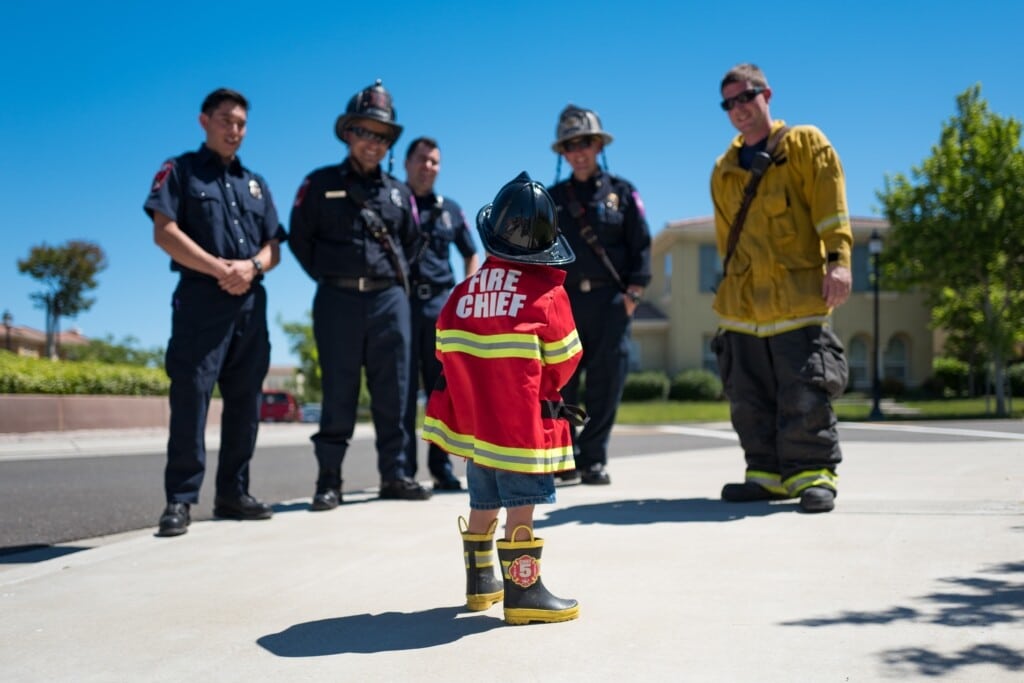Your Children and Fire Safety—How to Begin

A fire outside the normal confines of a campsite or fireplace can be harrowing for anyone. That is why fire safety still plays such a significant role, and when it comes to children, preparing them for a possible fire situation is especially crucial.
Getting your children ready for an emergency is vital for any age because you never know when disaster will strike—and fires are no different, whether in your home or elsewhere.
Read on for tips on best discussing fire safety with your kids.
Fire Safety Basics
When introducing fires and fire safety to your children, it’s essential to do so in a way that does not frighten them. The appeal of a fire’s light and warmth can be unavoidable, so providing children with appropriate guidance can avoid turning this draw into a dangerous fascination. Here are the basics of any fire safety discussion:
1. Keep Calm & Keep it Simple
Talking about fires and their destruction can be daunting to anyone, especially younger people. Calmly discuss the dangers of fire, answer questions constructively, and try to understand where the children are coming from. Make them aware of the danger, but keep it simple and easy for them to apply your instructions.
2. Prioritize Evacuation
Your children should know that getting them out of a dangerous situation is your top priority. Explain that toys and possessions are entirely replaceable, and they need to get out first. Firefighters will look after anything that is left behind.
3. Provide a Plan
A simple escape plan will help kids remain calm and practice safety. Knowing they are prepared with this plan might help them remain level-headed, even in an emergency. Decide on the best routes out of the house, determine a family meeting point in case of separation, and let your kids draw up maps to make it more enjoyable.
4. Turn it Into Something Fun
Speaking of enjoyment, try to turn fire awareness discussion into fun learning activities for children to lessen their fear about the topic. You can play “Fireman Simon Says” to teach safe movement or take kids to the local fire station to meet the firefighters. You can even list off instructions to the tune of a children’s song.
A fun way for kids to learn more about fire safety is through the U.S. Forestry Service and their successful public service campaign, Smokey Bear. You can find coloring pages and activities directly on the Smokey website, as well as other fire safety resources. With the help of America’s cartoon grizzly, kids can have fun with fire safety.
5. Talk About When to Call 9-1-1
Teach your children from a young age that dialing 9-1-1 during an emergency is the best response. This extends to fire safety, as well—children should know to call 911’s emergency services as soon as they spot a fire, in their own home or nearby.
Fire Safety for When at Home
Talk with your kids about what to do if there is a fire in the home. This is important to cover as children may see the family home as a safe sanctuary where nothing bad happens. However, preparing them for the specifics of an at-home fire is crucial should the worst happen. Here are some ideas on what to discuss:
1. Check Doors for Heat
In the case of a fire, kids should know how to use their hands to guide them and not their eyes. Since smoke will likely be heavy, teach children how to use the back of their hand on a door to see if it’s hot or not before proceeding to the exit. If kids are hesitant or don’t want to listen, make it more fun by blindfolding them and turning it into a game.
2. Check Smoke Detectors
Share with your children how necessary smoke detectors are in preventing fires. Familiarize kids with the alarm sound and associate the noise with fire to prevent extra surprise and fear if it goes off.
Teach your kids that they must get out of the house and call 911 immediately if the alarm goes off. Get them involved in reminding you to routinely check all the smoke detectors around the house and replace all the batteries twice a year.
3. Don’t Play in the Kitchen
Don’t let your children play in the kitchen! There are so many hazards in the kitchen space, including hot appliances, pot handles, and plug sockets, that it can be a recipe for disaster. Teach children that the kitchen is for cooking, not playing and that they need adult supervision when making food.
4. Get Escape Ladders
Escape ladders can be crucial to an escape but can also be tricky to use. Make sure to demonstrate and practice using these ladders with your children. They should know where the escape ladders are located and how to use them.
5. Never Play with Fire Starters
Ensure that your children know never to play with matches, lighters, ignition sources, or incendiary items such as candles. If they see any of these fire starters left out, children should tell an adult immediately and not touch them.
Additionally, children should be taught not to touch plugs or sockets. Fiddling with electrical appliances and outlets is incredibly dangerous, even if you have plug guards installed, so tell your kids to avoid them.
6. Plan Your Escape Routes
Have multiple escape routes for children, based on where a fire could be in the home. Practice these routes often so they are comfortable with them. Additionally, teach escape route safety techniques: if an exit is blocked, go to a room with a window to yell for help. Put clothes, blankets, or towels along the bottom of doors to block out smoke.
7. Practice Crawling
One of the most efficient and life-saving fire tactics is to crawl. When having to escape a burning building, smoke will be heavy throughout. But with proper crawling, you and your kids can safely move under the smoke and exit. So, teach your kids how to crawl around the house like caterpillars. While you may look silly now, it may just save you and your family’s lives later.
8. Practice Opening Windows
Learning how to open windows and take out any bug screens is essential for older children. Sometimes, the only way out is the window, so kids need to know how to open and create access to this portal. Practice this monthly and teach safe falling and landing techniques if the windows are high up.
9. Stay Out of the House
Children must understand to never, ever go back into a burning building—no matter what toy or game might have been left there. Instead, they can find an adult to help and leave the job to the fire department. Explain that possessions are replaceable, but they are not.
10. Stop, Drop, & Roll
Kids should know what to do for their safety if the fire gets too close. One of the most well-known instructions for a fire is to teach your kids to stop, drop, and roll. The need for this can be scary as the fire would be in very close proximity, but parents have had success in teaching children to stop, drop, and roll by turning it into a game.
11. Teach Children Your Details
While younger children might find it more difficult, teaching children your house address is vital in case of a fire. They should still know the neighborhood and general location if they cannot memorize the exact details. Above all, teach your kids to phone 911 in an emergency and which neighbors they can go to for help.
Fire Safety for the Great Outdoors
Camping and campfires go hand and hand. Whether pitched on a beach or in the woods, a toasty fire is quintessential to sleeping outside. But with such open campfires, giving your kids a few fire safety tips is important before the marshmallows come out.
1. Always Have Water
It’s important to have water on hand to douse the flames. So show your children where you keep the water bucket and shovel. That way, both items are nearby and ready to go in the event of a fire.
2. Cool Used Matches
It is best to establish a rule that your children must not touch a match unless an adult is present and willing to supervise. Even when matches are no longer lit, they are hot. So, ensure your children know matches need to cool before being discarded.
3. Keep Your Distance
Campfires are wonderfully mysterious, but children need to know the boundaries around the flames. Older children will likely be more receptive, but you can make a visual boundary with large stones to keep all kids aware of the danger zone.
4. Wood In, Nothing Out
Kids may be tempted to toss just about anything into the campfire, from graham crackers to toys. So, it’s important to tell them not to put anything into the fire but wood and never to take anything out of it.
While tending a campfire is an adult’s job, kids can still feel involved. Allow your children to forage for wood and sticks for the fire.
Wrapping Up
Many points were covered, so before you leave to teach your kids about fire safety, let’s review a few simple tips.
- Call 911 on the phone immediately, asking for Fire and Rescue. Give the address of the fire calmly and follow any instructions the 911 operator gives.
- Tell an adult if fire or smoke is spotted.
- Get out of the building as quickly as possible.
- Never go back into the building for anything.
- Don’t hide somewhere if there is a fire or the fire alarm is going off—get out of the house to safety.
For more helpful tips on staying safe when disaster strikes, check out our blog on flood preparation.



